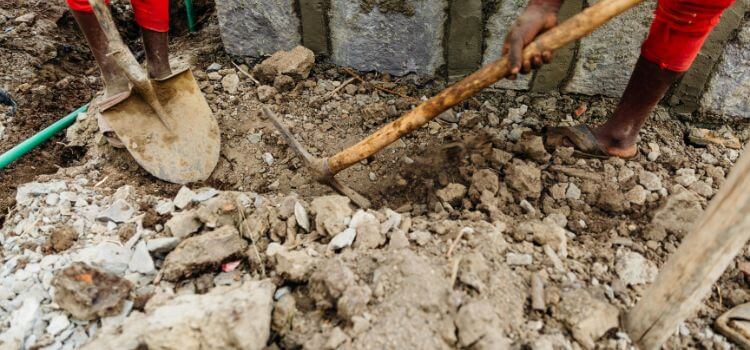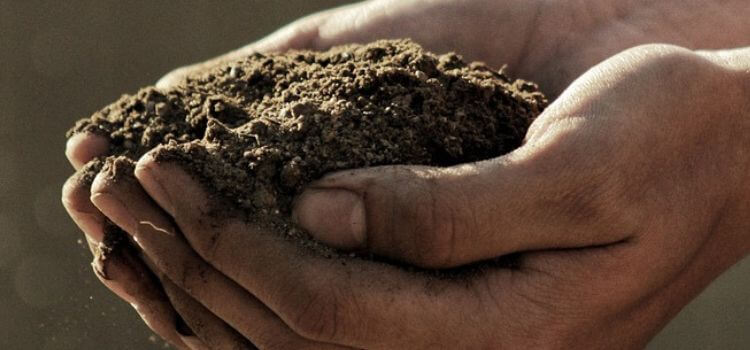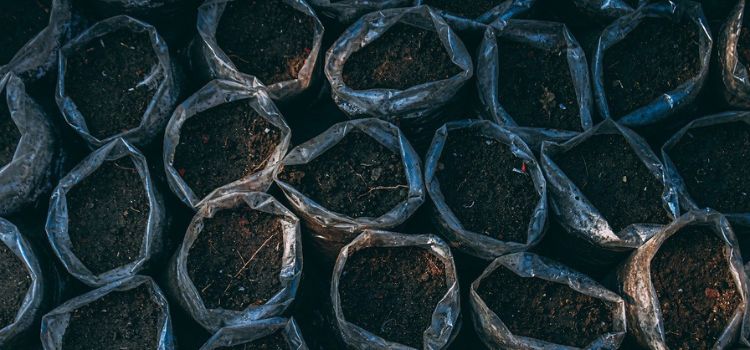As an Amazon Associate, I earn from qualifying purchases.
Use a garden fork or shovel to dig and sift the soil to remove rocks from the soil—separate rocks by hand or with a screen.
Rocks in soil can hinder plant growth and make gardening difficult. Removing these rocks can improve soil quality and plant health. Tools like garden forks, shovels, and soil screens can make the process easier. A garden fork loosens the soil, allowing rocks to be lifted out.
A soil screen helps sift smaller rocks from the soil. Consistently checking and removing rocks ensures a healthier garden environment. For larger areas, consider using mechanical rock removal equipment. This method saves time and effort. Removing rocks enhances soil structure and promotes better root development.
Why Rocks In Soil Are A Problem
Removing rocks from the soil is crucial for healthy plant growth. Rocks in soil can hinder root development and water absorption. Understanding why rocks in soil are a problem can help you achieve a thriving garden.
Rocks in soil can create many issues for plants and gardeners. They can damage gardening tools and equipment and make it hard for roots to grow and spread.

Damage To Gardening Tools
Rocks can dull or break tools like shovels, tillers, and plows. This not only increases your effort but also your costs for tool maintenance and replacement.
Hindering Root Growth
Rocks block roots from spreading out in search of water and nutrients, stunting plant growth and reducing crop yields. Plants need space to grow strong and healthy.
Poor Water Absorption
Soil with rocks does not absorb water well. Water can pool around stones, leading to root rot or poor drainage. This affects the overall health of your garden.
Soil Compaction
Rocks can compact the soil, making it harder for plants to grow. Compacted soil reduces air pockets essential for root respiration, leading to weak and unhealthy plants.
Table Of Key Problems Caused By Rocks In Soil
| Problem | Effect on Plants |
|---|---|
| Damage to Tools | Increases gardening costs |
| Hinders Root Growth | Stunts plant growth |
| Poor Water Absorption | Leads to root rot |
| Soil Compaction | Weakens plants |
Rocks in the soil create many problems for gardeners and plants alike. Removing them can lead to healthier soil and better plant growth. Understanding these issues is the first step to a thriving garden.
Assessing The Soil
Removing rocks from soil can be daunting. Assessing the soil is the first step in this process. By understanding the composition and types of rocks present, you can develop an efficient plan to clear your garden or yard.
Determining The Rock Content
Before removing rocks:
- Determine the amount of rock content in your soil.
- Start by digging a small test hole about 12 inches deep.
- Examine the soil you dig up.
- Look for visible rocks and pebbles.
Follow these steps to measure rock content:
- Digging Test Holes: Dig multiple test holes across your yard. This helps to get a better idea of overall rock content.
- Sifting Soil: Use a garden sieve or screen to sift the soil. This will separate rocks from the soil.
- Weighing Rocks: Collect the rocks from each test hole and weigh them. This gives a quantitative measure of rock content.
For accurate results, create a table to record your findings:
| Test Hole Location | Depth (inches) | Rock Weight (lbs) |
|---|---|---|
| North Corner | 12 | 5 |
| South Corner | 12 | 7 |
| Center | 12 | 4 |
These steps help you determine the extent of the problem. With this information, you can plan the next steps in removing the rocks from your soil.
Rock Types
Identifying the types of rocks in your soil is crucial. Different stones require different removal methods. Look closely at the rocks you collect during your test digs.

Common rock types include:
- Granite: Hard and durable, gray or pink.
- Limestone: Softer, often white or light gray.
- Sandstone: Grainy texture, brown or red.
Use a simple table to categorize your findings:
| Rock Type | Colour | Texture |
|---|---|---|
| Granite | Gray/Pink | Hard |
| Limestone | White/Gray | Soft |
| Sandstone | Brown/Red | Grainy |
Preparing The Tools
Removing rocks from the soil is essential for healthy plant growth. Properly preparing the tools ensures efficiency and safety.
Gloves And Protective Gear
Wearing gloves and protective gear is crucial. It keeps you safe from injuries while handling rocks and soil. Here are some essential items to consider:
- Gloves: Choose thick, durable gloves. They protect your hands from cuts and abrasions.
- Safety Goggles: These shield your eyes from dust and debris.
- Knee Pads: Protect your knees if you need to kneel while working.
- Sturdy Boots: Wear boots with an excellent grip to prevent slips and falls.
Using protective gear ensures safety and increases efficiency. You can work longer and more comfortably. Always inspect your gear for wear and tear, and replace any damaged items promptly to maintain safety standards.
Essential Tools
Having the right tools makes the job easier and quicker. Here’s a list of essential tools you’ll need:
| Tool | Purpose |
|---|---|
| Shovel | For digging and removing soil. |
| Rake | To gather rocks and debris. |
| Wheelbarrow | For transporting rocks and soil. |
| Sieve | To separate rocks from soil. |
Using a shovel and rake helps loosen and gather the rocks. A wheelbarrow makes it easy to move large amounts of rocks and soil. A sieve is excellent for finer separation, ensuring no small stones remain in the soil.
Ensure your tools are in good condition. Clean them after each use to prolong their life. Sharpen the edges of shovels and rakes regularly for better performance.
Removing Small Rocks
Removing rocks from soil is an essential task for gardeners and farmers. Rocks can hinder plant growth and damage tools. Small stones can be tricky to remove as they are often mixed throughout the soil. Below, we will explore two effective methods for removing small rocks from soil: hand picking and raking.
Hand Picking
Hand-picking is a straightforward method. This technique is ideal for small gardens or areas with a manageable number of rocks. Here’s how to do it:
- First, wear sturdy gloves to protect your hands.
- Next, kneel or squat close to the soil. This position makes it easier to spot small rocks.
- Then, gently sift through the soil with your fingers.
- Place any rocks you find in a bucket or container.
Advantages of Hand Picking:
- Cost-effective: Requires no special tools.
- Precise: You can ensure all rocks are removed.
Disadvantages of Hand Picking:
- Time-consuming: Not suitable for large areas.
- Physically demanding: Can strain your back and knees.
Hand-picking is best for small plots or raised beds. It’s also a great way to bond with your garden, giving you a closer look at your soil’s condition.
Using A Rake
Using a rake is another effective method for removing small rocks. This method works well for larger areas. Follow these steps:
- Choose a garden rake with sturdy tines.
- Rake the soil in a single direction to gather rocks into a pile.
- Collect the rocks and place them in a container.
- Repeat the process until the area is clear of rocks.
Advantages of Using a Rake:
- Efficient: Covers larger areas quickly.
- Less physically demanding: Easier on your back.
Disadvantages of Using a Rake:
- Less precise: Smaller rocks might be missed.
- Tool dependent: Requires a good quality rake.
Using a rake is suitable for preparing large garden beds or fields. It’s a faster way to clear an area of small rocks, saving time and effort.
Removing Large Rocks
Removing rocks from the soil can be challenging. Large stones, in particular, are particularly difficult to handle. They can damage tools and make planting difficult.
Using A Shovel
A shovel is a basic but powerful tool for removing large rocks. Begin by assessing the area where the rocks are located. Clear any debris around the rocks to get a clear view.
Follow these steps to remove rocks with a shovel:
- Loosen the soil around the rock using the pointed end of the shovel.
- Dig a trench around the rock to expose its edges.
- Wiggle the shovel under the rock to lift it slightly.
- Use leverage to pry the rock out of the ground.
For very large rocks, you might need to dig deeper and use a longer shovel. If the rock is too heavy, you may need to break it into smaller pieces. Safety tip: Always wear gloves to protect your hands from sharp edges.
Using A Wheelbarrow
After loosening and lifting the rocks, you will need to move them. A wheelbarrow is ideal for this task. It helps you transport heavy rocks without straining your back.
Here’s how to use a wheelbarrow effectively:
- Position the wheelbarrow close to the rock you want to move.
- Use the shovel or a partner to lift the rock into the wheelbarrow.
- Ensure the rock is balanced in the wheelbarrow to prevent tipping.
- Push the wheelbarrow to your desired location.
For extremely large rocks, consider using a ramp to roll the rock into the wheelbarrow. Safety tip: Always lift with your legs, not your back, to avoid injury.
Using these methods will make the task of removing large rocks easier and safer.

Preventing Rocks In Soil
Removing rocks from soil can be a daunting task, especially if you have a large garden. Preventing rocks in soil can save you a lot of time and effort. By implementing simple strategies, you can ensure your soil remains rock-free and fertile. Here’s how you can prevent rocks from infiltrating your garden soil.
Installing A Barrier
One effective way to prevent rocks from entering your soil is by installing a barrier. Barriers can be physical structures that block rocks from migrating into your garden area. Here are some methods:
- Landscape Fabric: Place landscape fabric over your soil before adding mulch or other coverings. This helps in keeping rocks out while allowing water to pass through.
- Garden Edging: Install garden edging along the perimeter of your garden. This keeps rocks from rolling into your soil.
- Gravel Barriers: Create a gravel border around your garden. The gravel catches any rocks before they enter your planting area.
Consider using a combination of these barriers for the best results. For example, you can lay landscape fabric and cover it with a layer of gravel. Then, add garden edging to further prevent rocks from infiltrating.
| Barrier Type | Advantages | Disadvantages |
|---|---|---|
| Landscape Fabric | Easy to install, allows water flow | May need replacement over time |
| Garden Edging | Durable, aesthetic | Can be expensive |
| Gravel Barriers | Effective rock prevention, low cost | Requires maintenance |
Amending The Soil
Another way to prevent rocks in the soil is by amending the soil. This involves improving the soil structure to make it less prone to retaining rocks. Here are some tips:
- Compost Addition: Add compost to your soil to improve its texture and fertility. This helps in breaking up existing rocks and prevents new ones from settling.
- Sand Mixture: Mix sand into your soil. Sand particles help in breaking down larger rock fragments and improve drainage.
- Regular Tilling: Till your soil regularly to break up compacted areas. This process brings hidden rocks to the surface, making it easier to remove them.
When amending soil, focus on the top 6-8 inches. Most plant roots grow here, so keeping this layer rock-free is crucial. Use a garden fork or tiller to mix the amendments thoroughly.
Creating a balanced soil mixture helps in reducing the presence of rocks. Aim for a mix of one-third compost, sand, and native soil. This combination provides nutrients, improves drainage, and reduces rock content.
You can maintain a rock-free garden by amending the soil and installing barriers. These methods not only keep rocks out but also enhance the overall quality of your soil.

Frequently Asked Questions
Use a garden sieve or screen to separate stones from soil. Rake through the soil to remove larger rocks.
The easiest way to dig up rocks is to use a shovel or a mattock. Loosen the soil around the stones first. For larger rocks, use a pry bar. Always wear gloves and safety gear.
Remove rocks by using a shovel or pickaxe. Dig around large rocks to loosen them. Use a wheelbarrow for transport. For smaller rocks, use a soil sifter. Renting a power tiller can help break up rocky soil.
A rock picker or landscape rake effectively removes rocks from a yard. These machines make yard cleanup easy and efficient.
Conclusion
Removing rocks from the soil is essential for healthy plant growth. Use the right tools and techniques for the best results. Regularly check and maintain your garden soil to ensure plants receive the nutrients they need. Follow these steps, and your garden will thrive, free from the hindrance of unwanted rocks.


